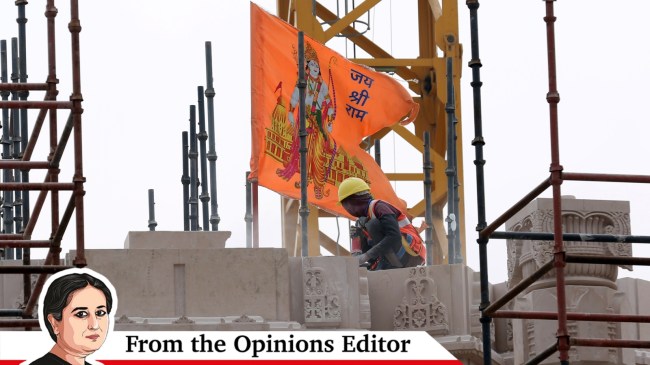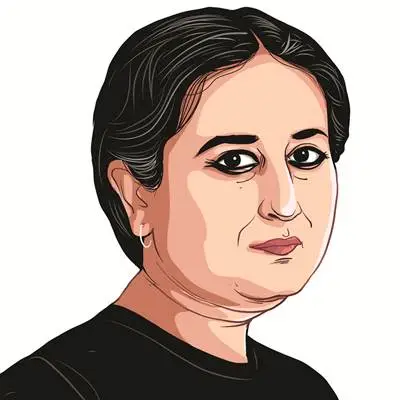Opinion Vandita Mishra writes: A consecration in Ayodhya
It will mark BJP politics coming full circle, having shifted the centre of gravity
 Construction underway at the Ram Temple in Ayodhya. (Express file photo by Vishal Srivastav)
Construction underway at the Ram Temple in Ayodhya. (Express file photo by Vishal Srivastav) Dear Express Reader
The drum roll has begun, consecration of the Ram temple in Ayodhya will be a national event, it is being made into one. The nation’s Prime Minister will be at the centre of the religious rituals and ceremonies on January 22 — as he was on August 5, when amid a pandemic in 2020, he laid the foundation stone of the temple at the site where the Babri Masjid stood before it was felled by a mob in 1992. And the main Opposition party, Congress, stands still, still seized by the question: To go to Ayodhya, or not to?
This tableau, bookended by Delhi and Ayodhya, is a defining one, not just for January 22 or 2024, but well beyond that date and this year. It frames a deepening entrenchment of the idea of the BJP, and on its other side, a continuing irresolution.
“New Ayodhya”, with the temple its centrepiece, is not merely part of the BJP’s grand architecture and installation project of “New India” — which, in the national capital, includes the remade Central Vista and the all-new Parliament building. It is also an assertion of arrival — of a visible Hindu religiosity at the heart of the public. For all its imperfections and distortions at the hands of secularists, for all the lapses and lip service, secularism, defined as equal respect for all religions, if not as the separation of state and religion, has been an article of faith in this country. In the BJP’s “New India”, it isn’t.
Of the three Ms that redefined politics after the 1990s — Mandal, Mandir and Market — Mandir has proved to be the most successful project, carving out a relatively stable national community, and showing the capacity to coopt and domesticate, when needed, the radical or contending impulses unleashed by the other two. The success of the BJP project, as much as the Ram temple, will be consecrated on January 22 in Ayodhya.
Over these years, as it journeyed from being the chief disruptor to the new centre of gravity, Mandir politics has also acquired several layers and careful overlays, and even, strategic camouflage. The temple is being unveiled at a time when Hindutva politics projects it as a site and signifier of a wider convergence — of old and new, modernity and tradition, identity and development, cultural assertion and infrastructure upgrade and the welfare scheme.
Of course, despite its evident successes, the BJP’s project has cracks, and it papers over a grave injustice. The cracks are there because it attempts to impose homogeneity on diversity, and because there are multiple ways of being Indian, and even Hindu, that are excluded from or downplayed in its programme of tidy uniformity. The grave injustice is done to Muslims, the country’s largest minority who are to be treated equally as beneficiaries or “labharthi”, not as rights-bearing citizens entitled to a political voice and representation.
But an Opposition spooked by the BJP’s serial electoral victories, paralysed by its own mistakes in the past and lack of conviction going ahead, is unable and unwilling to show up either the cracks in the BJP’s project, or its injustice.
And then, up ahead in this election year, these parties don’t just need to fight the BJP. They also need to frame a political alternative, while addressing the accumulated cynicisms and disbeliefs among the people towards them. But so far, there is little or no movement forward in any of those directions.
The joint anti-BJP front seems wholly convulsed by seat-sharing arithmetic. The Congress, its largest constituent, has put one foot forward to begin the second phase of the Bharat Jodo Yatra, while the other is mired in the Ayodhya indecision. And in West Bengal, a prominent INDIA member has rung in the new year with a display of an older syndrome that has shadowed its governance and politics — a mob of TMC supporters attacked a team sent by the Enforcement Directorate to the home of its leader, while its government looked away. The TMC has brought it upon itself — all its justified outrage about the Centre’s misuse of central agencies against its political opponents will now be seen as whataboutery.
It will be easy to see PM Modi on stage at the grand event in Ayodhya and attribute the change to him. After all, he is at the centre of each frame — of temple and nation, temple and politics, temple and government. But whether or not his government is re-elected in the coming election, his real victory could be that the changes he has tapped into and unfurled will outlive his rule.
It may or may not be incidental that in the run-up to the grand unveiling in Ayodhya, the Chief Justice of the apex court that handed over the disputed site to the deity even as it called the mosque’s destruction “an egregious violation of the rule of law”, borrowed the language of the temple to make his point about justice.
In Gujarat on Saturday, CJI DY Chandrachud urged district court lawyers to function in a manner that the “dhwaja of justice” keeps flying — referring to the dhwaja or flag atop the Dwarka and Somnath temples which he visited during a two-day visit to the state.
Till next week,
Vandita





